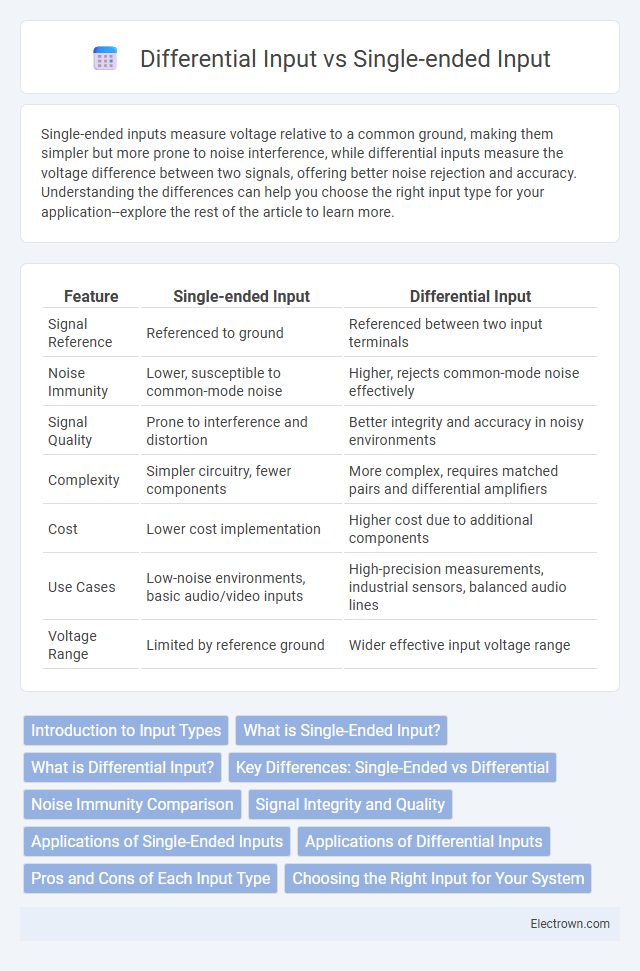Single-ended inputs measure voltage relative to a common ground, making them simpler but more prone to noise interference, while differential inputs measure the voltage difference between two signals, offering better noise rejection and accuracy. Understanding the differences can help you choose the right input type for your application--explore the rest of the article to learn more.
Table of Comparison
| Feature | Single-ended Input | Differential Input |
|---|---|---|
| Signal Reference | Referenced to ground | Referenced between two input terminals |
| Noise Immunity | Lower, susceptible to common-mode noise | Higher, rejects common-mode noise effectively |
| Signal Quality | Prone to interference and distortion | Better integrity and accuracy in noisy environments |
| Complexity | Simpler circuitry, fewer components | More complex, requires matched pairs and differential amplifiers |
| Cost | Lower cost implementation | Higher cost due to additional components |
| Use Cases | Low-noise environments, basic audio/video inputs | High-precision measurements, industrial sensors, balanced audio lines |
| Voltage Range | Limited by reference ground | Wider effective input voltage range |
Introduction to Input Types
Single-ended inputs measure voltage with reference to a common ground, making them simpler but more susceptible to noise and interference. Differential inputs, on the other hand, measure the voltage difference between two input signals, offering improved noise rejection and signal integrity in complex or noisy environments. These fundamental differences influence the choice of input type in applications like audio equipment, instrumentation, and sensor interfacing, where signal quality and noise tolerance are critical.
What is Single-Ended Input?
Single-ended input refers to a signal input method where the voltage is measured between a single signal line and a common ground reference. This type of input is simpler and more cost-effective but is more susceptible to noise and interference compared to differential input. Your choice depends on the application's noise environment and signal integrity requirements.
What is Differential Input?
Differential input measures the voltage difference between two input terminals, providing noise rejection and improved signal integrity compared to single-ended input. It is commonly used in audio equipment, instrumentation amplifiers, and communication systems to minimize interference and ground loop issues. This input method enhances accuracy in sensitive applications by amplifying only the voltage difference while rejecting common-mode signals.
Key Differences: Single-Ended vs Differential
Single-ended inputs measure voltage referenced to a common ground, making them more susceptible to noise and interference, while differential inputs compare the voltage difference between two signals, significantly enhancing noise rejection. This key difference allows differential inputs to provide higher accuracy and better signal integrity in environments with electrical noise. Choosing differential input for your system ensures improved performance, especially in precision measurement applications.
Noise Immunity Comparison
Differential inputs provide superior noise immunity compared to single-ended inputs by rejecting common-mode noise through the subtraction of signals received on two conductors. In environments with significant electromagnetic interference (EMI), differential inputs maintain signal integrity by minimizing noise influence, ensuring more accurate and stable readings. Your choice of input type directly impacts the accuracy of sensitive measurements, especially in industrial or high-noise applications.
Signal Integrity and Quality
Single-ended inputs are more susceptible to noise and electromagnetic interference, which can degrade signal integrity and reduce quality, especially over long cable runs. Differential inputs improve signal integrity by using two complementary signals that cancel out common-mode noise, resulting in higher signal quality and better performance in noisy environments. Your choice of input type directly impacts the accuracy and fidelity of the received signals in sensitive electronic applications.
Applications of Single-Ended Inputs
Single-ended inputs are widely used in audio equipment, sensor interfacing, and analog signal processing where signal simplicity and cost-effectiveness are priorities. They suit applications such as consumer electronics, instrumentation with short cable runs, and systems where environmental noise is minimal. Your choice of single-ended input benefits from easier integration and reduced circuit complexity in these scenarios.
Applications of Differential Inputs
Differential inputs are widely used in high-precision measurement systems, audio equipment, and communication devices due to their ability to reject common-mode noise and interference. Your signals benefit from improved noise immunity and enhanced signal integrity, particularly in environments with significant electromagnetic interference (EMI). Industrial sensors, instrumentation amplifiers, and data acquisition systems rely on differential inputs to maintain accuracy and reliability in critical applications.
Pros and Cons of Each Input Type
Single-ended inputs are simpler and cost-effective, ideal for low-noise environments but more prone to interference and ground loop issues due to a single reference point. Differential inputs offer superior noise rejection and signal integrity by measuring voltage differences between two terminals, making them suitable for high-precision and noisy environments but often require more complex and expensive circuitry. Choosing between these inputs depends on your system's noise environment and precision requirements, balancing complexity with performance.
Choosing the Right Input for Your System
Selecting between single-ended and differential inputs depends on your system's noise environment and signal integrity requirements. Differential inputs provide superior noise rejection and are ideal for long cable runs or electrically noisy environments, while single-ended inputs offer simplicity and lower cost for short distances with minimal interference. Evaluating signal-to-noise ratio, cable length, and system complexity ensures optimal input choice for reliable data acquisition.
Single-ended vs Differential input Infographic

 electrown.com
electrown.com